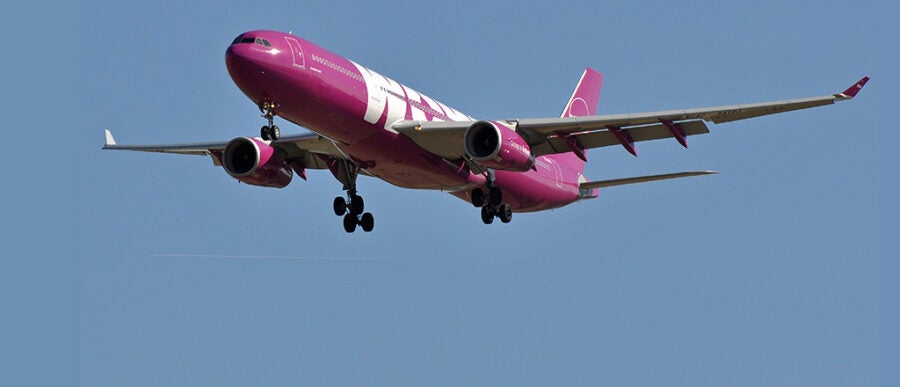Flying the friendly skies is getting more turbulent — at least for transatlantic travel. Buoyed by low oil prices and new fuel-efficient aircraft, several low-cost European carriers are challenging major legacy airlines in the lucrative U.S.-Europe market, with sometimes jaw-droppingly low fares.
Iceland’s Wow Air has offered base fares as low as $55 one-way from the West Coast and Miami to Europe. Norwegian Air Shuttle fares came down as low as $69 to fly across the pond in the summer. In June, British Airways parent IAG launched its own transatlantic low-cost carrier, Level. It has offered flights from Los Angeles to Barcelona starting at $149. Air France is getting ready to launch its own budget carrier, Boost.
To be sure, ancillary fees often pad the base fares of budget carriers. These charges run the gamut from those for checked baggage including carry-ons, meals, in-flight entertainment, seat reservations, blankets and pillows as well as printing out a boarding pass. It is also not unusual to see a rock-bottom departure fare with a much higher one for the return. But despite the fees, budget carriers are still cheaper than big airlines.
Low-cost carriers are able to slash prices by keeping operating and labor costs low — flying newer and more fuel-efficient planes that can travel farther without refueling, executing shorter plane turnaround times to maximize flying time, avoiding expensive airports in big cities, hiring younger staff at lower pay, selling tickets directly to consumers online and other cost-saving moves, says Wharton operations, information and decisions professor Gerry Tsoukalas, who has studied airlines. “As long as this remains true [and fuel prices stay low], it shouldn’t be a surprise if these types of airlines can be successful and gain some market share. Legacy carriers either cannot or do not want to compete on all of these dimensions.”
Regulatory changes also motivated European budget carriers to start transatlantic service. In 2008, amendments to the U.S. and the European Union “Open Skies” agreement took effect. It let both sides’ airlines fly freely between their cities, and extended the rights to some non-EU nations such as Switzerland. Before the amendment, each European nation had to strike a bilateral air transport agreement with the U.S. and faced other restrictions.
The arrival of low-cost, long-haul airlines — ones that fly to destinations six hours out or longer — are already putting market pressure on transatlantic fares. The median airfare from the U.S. to 20 European cities is down 20% compared to a year ago, according to Time magazine, citing figures from travel site Kayak. Well-traveled cities such as Paris, Amsterdam and Barcelona saw greater dips of more than 30% due to stiffer competition.
In domestic travel, the feasibility of low-cost carriers is a proven story with the success of Southwest, JetBlue and others. They have showed “beyond doubt that a low-cost, low-price model is sustainable,” Tsoukalas says. Overseas travel is another matter. While “demand for cheap tickets isn’t a fad and many people are willing to sacrifice convenience on short trips, whether this readily extends to long-haul travel remains to be seen.” However, he adds, early indications show that it works for certain markets.
“As long as this remains true [and fuel prices stay low], it shouldn’t be a surprise if these types of airlines can be successful and gain some market share.”–Gerry Tsoukalas
Skytrain and People Express
As part of its homage to pioneers, Norwegian Air Shuttle said earlier this year that it would feature Sir Freddie Laker on the tail fins of its Boeing 737 Max planes. The British entrepreneur founded Laker Airways, which launched Skytrain in the 1970s, the first low-cost transatlantic airline to fly directly between London and New York, according to a research paper by Peter Morrell, a visiting professor at the Department of Air Transport at Cranfield University in the U.K. and author of Airline Finance.
Skytrain flew point-to-point, or without stopovers. It charged for in-flight meals, packed people into one class of 345 seats and used only McDonnell Douglas DC-10s to simplify staff and maintenance crew training. It offered fares of 32.50 pounds when full-fare rivals charged about 100 pounds. Initially, people had to queue to get on the flight; it didn’t have advance bookings and the internet wasn’t around yet. Skytrain failed in 1982 during an economic downturn after big carriers cut their fares.
In the 1980s, the U.S. saw its own low-cost, long-haul carrier emerge: People Express. It flew between New York and London. The airline cut costs by paying modest salaries but added profit sharing, and its crew multitasked — for example, pilots helped with the luggage, according to The New York Times. But the big carriers also cut costs and lowered prices, betting that travelers wouldn’t mind paying a little extra for full service. People Express expanded too fast and went bust in 1987.
While long-haul budget airlines were flailing, low-cost upstart Southwest Airlines took off by specializing in no-frills short-haul flights. It launched its first flight in 1971 with six roundtrip fares between Dallas and San Antonio, Texas, and 12 trips between Dallas and Houston, charging $20 each way. Today, Southwest and other low-cost carriers — JetBlue, Spirit and Frontier, among others — have changed the way Americans travel.
As they got bigger, low-cost carriers added more frills such as seat reservations and frequent flier programs, according to a market outlook report from Boeing. They’ve also expanded their routes to include parts of the Caribbean and Latin America. Some are adding premium class and targeting business travelers. Major airlines are copying budget carriers, too: charging for baggage and meals, and rolling out “basic economy” fares, among other offerings.
Tsoukalas predicted in a 2008 research paper that low-cost carriers and legacy airlines would see a “cost convergence.” “To some extent, this has been happening,” he explains. “Legacy carriers in the U.S. have used consolidation and Chapter 11 [bankruptcy reorganization] to reduce part of their cost base, while low-cost carriers have had to deal with increasing staff seniority, which has driven wages higher.”
“Legacy airlines have the advantage of having a large number of airplanes and can fly to many more places than budget airlines.”–Z. John Zhang
Back then, major carriers didn’t pay too much attention to low-cost rivals until Southwest and other budget carriers became serious competition. They’re not going to make the same mistake with European low-cost carriers, Tsoukalas says. “The effect [of low-cost carriers] so far has been limited in the grand scheme of things, but it’s clear Norwegian’s move into low-cost long haul travel didn’t go unnoticed. Most legacy carriers have learned their lesson when it comes to ignoring low-cost carriers.”
Legacy Airlines’ Advantages
But budget airlines face a tough uphill battle when it comes to unseating major carriers in the long-haul market. “Legacy airlines have the advantage of having a large number of airplanes and can fly to many more places than budget airlines. They have many more alliances with many airlines to many cities,” says Wharton marketing professor Z. John Zhang, who studies pricing.
With major airlines, travelers can connect at airline hubs to go to myriad destinations. It is more complicated with a budget carrier. For example, flying from Philadelphia to Bern, Switzerland could entail taking a connecting flight on a major airline through the Frankfurt, Germany hub, according to Zhang. This network of connections works to the advantage of big carriers. “If you fly a budget airline, you land in Frankfurt and then what do you do? Take your luggage out and check it in again” at another carrier?
Another reason why long-haul travel is harder for budget carriers to succeed in than short-haul is that the cost-conscious consumers they are targeting tend to be leisure travelers. But leisure travelers usually take long flights — say from Chicago to Paris — when they are embarking on a big vacation, and they don’t do that too often. They also tend to want more comfort since they are flying long hours. Moreover, on a big vacation, the airfare is probably not the biggest expense, according to Zhang.
“I think there’s room for a couple that do this pricing very well to succeed because there is a market.”–Senthil Veeraraghavan
Typically, long-haul flights are mostly taken by business travelers, Zhang adds. “Those business travelers don’t really care about the price as much [as leisure travelers]. They probably care more about services and scheduling, which means if an airline offers frequent flights, that’s a good thing.” Budget airlines usually fly to a smaller number of cities, offer fewer flights and might not fly daily to a destination. That is why Zhang is more bullish on major carriers. “Legacy airlines just need to leverage their advantages: networks, destinations and services.”
The good news is that Zhang sees the market expanding as travelers are lured by low airfares from all sides. “There will be more people flying across the Atlantic, which is good for the economy overall.” Wharton operations, information and decisions professor Senthil Veeraraghavan sees room for growth in long haul: Domestic, or short-haul, flights are running at about 84% full (load factor) whereas transatlantic flights are around 80%. He also expects the number of travelers to increase due to a rising middle class, particularly in China.
Tsoukalas expects budget transatlantic carriers to stay — for now. “Underpinning this trend has been a prolonged period of low fuel prices,” he says. “If this changes in the future, there could very well be a shakeout. When your business model relies on being able to sell transatlantic fares for $100, you aren’t very robust to [withstand] exogenous shocks that can affect your cost base.” His caveat: “The airline industry is very cyclical and this is difficult to predict.”
Veeraraghavan, however, sees a few budget carriers surviving in long-haul: “I think there’s room for a couple that do this pricing very well to succeed because there is a market.”
Photo credit: By Eric Salard from Paris, France – EC-MIN CDG, CC BY-SA 2.0, https://commons.wikimedia.org/w/index.php?curid=52273838



